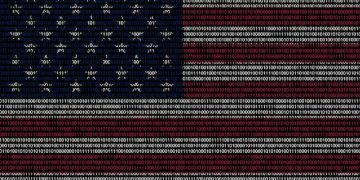Deepfakes and US Elections: Combating Misinformation in 2024

Deepfakes pose a significant threat to the integrity of US elections, prompting various measures to combat misinformation, including technological detection methods, legislative efforts, media literacy campaigns, and collaborative initiatives to safeguard the democratic process.
The rise of deepfakes and US elections: what measures are being taken to combat misinformation? is a growing concern, threatening to undermine the democratic process. These sophisticated forgeries, often created using artificial intelligence (AI), can convincingly mimic real people and events, making it increasingly difficult to distinguish fact from fiction. This article explores the challenges posed by deepfakes and the various strategies being employed to counter their potential impact on elections.
Understanding the Threat of Deepfakes in Elections
Deepfakes present a unique challenge to election integrity due to their ability to rapidly spread misinformation and sow discord. These manipulated media can erode public trust, influence voter opinions, and even incite violence. Understanding the nature of deepfakes and their potential impact is crucial for developing effective countermeasures.
What Exactly Are Deepfakes?
Deepfakes are created using AI techniques, primarily deep learning, to generate realistic but fake videos or audio recordings. These forgeries can make it appear as if someone said or did something they never actually did, potentially damaging their reputation or misleading the public.
The technology behind deepfakes has become more accessible, allowing individuals with limited technical skills to create convincing manipulations. This proliferation increases the risk of deepfakes being used maliciously in political campaigns or other contexts.
Potential Impact on US Elections
The use of deepfakes in elections could have severe consequences, including:
- Erosion of Trust: Repeated exposure to deepfakes can make the public skeptical of all information, even legitimate news sources.
- Influence on Voter Behavior: Deepfakes can be used to spread false narratives about candidates, potentially swaying voters based on misinformation.
- Incitement of Violence: In extreme cases, deepfakes could be used to incite violence or unrest by portraying candidates making inflammatory statements.
Combating deepfakes requires a multi-faceted approach that includes technological solutions, media literacy education, and legal frameworks. By understanding the threat and implementing effective strategies, it is possible to mitigate the potential damage caused by deepfakes in elections.

In conclusion, the emergence of deepfakes poses a significant threat to the fairness and integrity of US elections, necessitating proactive measures to address this challenge.
Technological Solutions for Deepfake Detection
Developing technological tools to detect deepfakes is a critical step in combating misinformation. AI-powered detection methods can analyze videos and audio recordings for telltale signs of manipulation, helping to identify and flag deepfakes before they can cause widespread damage.
AI-Powered Detection Methods
Researchers are developing AI algorithms that can analyze facial expressions, speech patterns, and other cues to identify discrepancies indicative of deepfake manipulation. These algorithms are constantly evolving to keep pace with advancements in deepfake technology.
One approach involves training AI models on large datasets of real and fake content, allowing them to learn the subtle differences between authentic and manipulated media. These models can then be used to analyze new videos or audio recordings and flag potential deepfakes.
Challenges and Limitations
Despite advancements in AI-powered detection, several challenges remain:
- Evolving Technology: Deepfake technology is constantly improving, making it difficult for detection methods to keep pace.
- Computational Resources: Analyzing videos and audio recordings for deepfakes requires significant computational resources, limiting the scalability of detection efforts.
- False Positives: Detection algorithms can sometimes produce false positives, incorrectly flagging authentic content as deepfakes.
Overcoming these challenges requires ongoing research and development, as well as collaboration between researchers, policymakers, and technology companies. By continuously improving detection methods and addressing their limitations, it is possible to enhance the ability to identify and mitigate the spread of deepfakes.
In conclusion, technological solutions are crucial for detecting and combating deepfakes, but they must be continuously refined to keep pace with evolving deepfake technology and address the challenges and limitations that exist.
Legislative and Regulatory Efforts to Combat Deepfakes
Legislative and regulatory actions play a vital role in addressing the threat of deepfakes in elections. By enacting laws that criminalize the creation and dissemination of malicious deepfakes, policymakers can deter bad actors and hold them accountable for their actions. Regulatory efforts can also help to establish standards and guidelines for responsible AI development and deployment.
Existing Laws and Regulations
Some states have already enacted laws that specifically address deepfakes, while others rely on existing laws related to defamation, fraud, and election interference. These laws typically prohibit the creation and distribution of deepfakes intended to harm a candidate’s reputation or influence the outcome of an election.
At the federal level, lawmakers have introduced legislation aimed at combating deepfakes, but no comprehensive federal law has yet been enacted. These proposed laws would typically establish penalties for creating and disseminating malicious deepfakes, as well as require platforms to label or remove deepfakes that violate their policies.
Proposed Legislation and Legal Frameworks
Several key considerations arise when drafting legislation to address deepfakes:
- Defining Deepfakes: Clear and precise definitions are needed to ensure that laws target malicious manipulations without infringing on free speech rights.
- Balancing Free Speech: Laws must strike a balance between protecting against misinformation and preserving the ability to create satire, parody, and other forms of creative expression.
- Enforcement Mechanisms: Effective enforcement mechanisms are needed to deter bad actors and hold them accountable for their actions.
Legislative and regulatory efforts are essential for establishing a legal framework to combat deepfakes and protect the integrity of elections. By carefully considering the key considerations and adopting effective measures, policymakers can help to deter the creation and dissemination of malicious deepfakes.
In closing, legislation and regulation are crucial in establishing a legal framework to combat deepfakes, requiring careful consideration of definitions, free speech, and enforcement mechanisms.

Media Literacy and Public Awareness Campaigns
Educating the public about deepfakes is essential for empowering individuals to critically evaluate information and resist manipulation. Media literacy campaigns can help to raise awareness about the existence of deepfakes, teach people how to identify them, and promote responsible information sharing.
The Importance of Media Literacy
Media literacy involves the ability to access, analyze, evaluate, and create media in a variety of forms. In the context of deepfakes, media literacy can help individuals to:
- Identify Deepfakes: Learn to recognize telltale signs of manipulation, such as unnatural facial expressions, inconsistencies in lighting or audio, and lack of corroborating evidence.
- Evaluate Sources: Assess the credibility of sources and be wary of information from unknown or unreliable sources.
- Share Responsibly: Think critically before sharing information and avoid spreading unverified or potentially manipulated content.
Strategies for Raising Public Awareness
Effective media literacy campaigns can employ a variety of strategies, including:
- Educational Programs: Incorporate media literacy education into school curricula and community workshops.
- Public Service Announcements: Create public service announcements that raise awareness about deepfakes and provide tips for identifying them.
- Collaborations with Media Outlets: Work with media outlets to produce articles, videos, and other content that educate the public about deepfakes.
By investing in media literacy education and raising public awareness, it is possible to empower individuals to become more discerning consumers of information and resist the manipulative tactics of deepfakes.
To summarize, media literacy and public awareness campaigns are crucial for empowering individuals to critically evaluate information and resist deepfake manipulation by enhancing identification, source evaluation, and responsible sharing.
Collaboration between Tech Companies, Governments, and Media Organizations
Combating deepfakes requires a coordinated effort involving tech companies, governments, and media organizations. By working together, these stakeholders can share information, develop best practices, and implement effective strategies to mitigate the threat of deepfakes in elections.
Sharing Information and Best Practices
Collaboration can facilitate the sharing of information about deepfake technology, detection methods, and emerging threats. Tech companies can share insights into the techniques used to create deepfakes, while researchers can share findings about effective detection strategies. Media organizations can share best practices for verifying information and reporting on deepfakes responsibly.
Governments can play a key role in fostering collaboration by convening stakeholders, providing funding for research and development, and establishing standards and guidelines for responsible AI development and deployment.
Developing Industry Standards and Guidelines
Collaborative efforts can lead to the development of industry standards and guidelines for:
- Deepfake Detection: Establishing common metrics and benchmarks for evaluating the performance of detection algorithms.
- Content Labeling: Developing standards for labeling manipulated media to inform viewers that the content may not be authentic.
- Content Removal: Creating guidelines for removing or demoting deepfakes that violate platform policies.
By working together to develop and implement these standards and guidelines, tech companies, governments, and media organizations can help to create a more transparent and trustworthy information ecosystem.
In conclusion, collaboration between tech companies, governments, and media organizations is vital for sharing information, developing best practices, and implementing effective strategies to combat deepfakes in elections.
Ethical Considerations and Responsible AI Development
The development and deployment of AI technologies, including those used to create and detect deepfakes, raise important ethical considerations. Responsible AI development requires careful attention to issues such as bias, transparency, and accountability.
Addressing Bias in AI Algorithms
AI algorithms can perpetuate and amplify existing biases if they are trained on biased data. To address this issue, it is important to:
- Diversify Training Data: Ensure that training datasets are diverse and representative of the populations that will be affected by the AI system.
- Monitor for Bias: Regularly monitor AI systems for bias and take steps to mitigate it when it is detected.
- Promote Transparency: Provide clear and transparent explanations of how AI systems work and how they make decisions.
Ensuring Transparency and Accountability
Transparency and accountability are essential for building trust in AI systems. This requires:
- Explainable AI: Developing AI systems that can explain their decisions in a way that is understandable to humans.
- Auditable AI: Ensuring that AI systems can be audited to verify their accuracy and fairness.
- Accountable AI: Establishing clear lines of accountability for the decisions made by AI systems.
By adhering to these ethical principles and promoting responsible AI development, it is possible to minimize the risks associated with AI technologies and maximize their potential benefits.
To conclude, ethical considerations and responsible AI development are vital for minimizing the risks while maximizing the benefits of AI technologies, addressing bias, and ensuring transparency and accountability.
| Key Point | Brief Description |
|---|---|
| 🚨 Deepfake Threat | Deepfakes can erode trust and influence voters. |
| 🤖 AI Detection | AI algorithms are used to identify manipulated content. |
| 🏛️ Legislation | Laws are being proposed to criminalize malicious deepfakes. |
| 📚 Media Literacy | Education is key to spotting deepfakes and sharing responsibly. |
Frequently Asked Questions
▼
A deepfake is a manipulated video or audio recording created using artificial intelligence, often used to convincingly mimic real people and events.
▼
AI algorithms can analyze facial expressions, speech patterns, and other cues to identify discrepancies indicative of deepfake manipulation.
▼
Creating and disseminating malicious deepfakes can lead to legal consequences, including penalties for defamation, fraud, and election interference.
▼
Media literacy empowers individuals to critically evaluate information, enabling them to identify deepfakes and resist manipulation strategies effectively.
▼
Various initiatives like educational programs, public service announcements, and media collaborations are being implemented to raise public awareness about deepfakes.
Conclusion
In conclusion, the challenge posed by deepfakes to US elections is multifaceted, requiring a combination of technological solutions, legislative measures, media literacy initiatives, and collaborative efforts to effectively combat misinformation and safeguard the democratic process.





